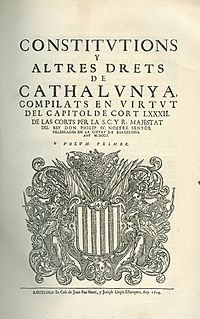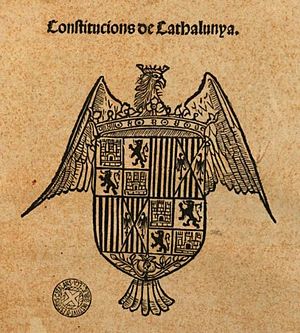Catalan constitutions facts for kids
Quick facts for kids Constitutions of CataloniaConstitucions de Catalunya |
|
|---|---|

Compilation of 1702
|
|
| Territorial extent | Principality of Catalonia |
| Enacted by | Catalan Courts |
| Date enacted | 1283 (first), 1706 (last) |
| Date effective | 1283 |
| Introduced by | Count of Barcelona |
| Related legislation | |
| Usages of Barcelona | |
The Catalan constitutions (Catalan: Constitucions catalanes) were the main laws of the Principality of Catalonia. These laws were created by the Count of Barcelona and approved by the Catalan Courts. The Corts in Catalan is like the word "courts" in English. But here, it means a special group of people who made laws, similar to a parliament.
The first of these laws were made in 1283. The very last ones were created in 1705. These laws were very important. They were more powerful than other rules and could only be changed by the Catalan Courts themselves. These collections of laws followed an old Roman way of organizing legal rules, like a big law book.
Contents
How the Laws Started: The Catalan Courts
The first collection of these laws was put together because Ferdinand I of Aragon asked for it. This happened after the Corts of Barcelona suggested it in 1413. This collection became widely known in 1495. It was published along with other important rules called the Usages of Barcelona.
One of these early law books was called:
- Usatges de Barcelona, Constitutions, Capitols, y Actes de Cort, y altras leys de Cathalunya (This means "Usages of Barcelona, constitutions, chapters and acts of court, and other laws of Catalonia").
Later, more collections of laws were agreed upon by the Corts in 1585 and 1702. These were published in three volumes:
- Constitutions y altres drets de Cathalunya ("Constitutions and other rights of Catalonia")
- Pragmaticas y altres drets de Cathalunya ("Pragmatics and other rights of Catalonia" - these were like special royal orders)
- Constitutions y altres drets de Cathalunya superfluos, contraris y corregits ("Constitutions and other rights of Catalonia, outdated, conflicting, and corrected")
When the Laws Ended: The Nueva Planta Decrees
After a big war called the War of the Spanish Succession, Philip V of Spain made some new rules. These rules are known as the Decretos de Nueva Planta in Spanish, or Decrets de Nova Planta in Catalan. These new rules got rid of the separate laws in areas that had supported his rival, Archduke Charles of Austria. This included all the lands of the Crown of Aragon.
Philip V wanted to make Spain a single, centralized country, like France. So, he made the laws of Castile apply to all of Spain. These changes started in Valencia and Aragon in 1707. By 1716, they were also put into place in Catalonia and the Balearic Islands. The only exception was Menorca, which was controlled by the British at that time.
This meant that the Catalan Constitutions were officially ended by the King. He did this after winning the war, not through any legal process in Catalonia itself. This change ignored the Catalan Constitution's own rules about how they should be changed or updated.
A Promise Not Kept: The Third Carlist War
During the Third Carlist War (1872–1876), a group called the Carlists took control of some cities in Catalonia. At this time, Queen Isabel II was not in power, and King Amadeo I was not very popular.
The Carlist leader, Charles VII of Spain, who wanted to be king, made a promise. He told the people of Catalonia, Valencia, and Aragon that if he won, he would bring back their old laws and constitutions. These were the same laws that Philip V had ended earlier.
However, this promise was never kept. The Carlist revolt did not succeed. Carlos María de los Dolores (Charles VII) left for France on February 27, 1876. On the very same day, Alfonso XII of Spain entered Pamplona, marking the end of the war.
See also
 In Spanish: Constituciones catalanas para niños
In Spanish: Constituciones catalanas para niños
- Principality of Catalonia
- Parliament of Catalonia
- Nueva Planta Decrees
- Civil Code of Catalonia


